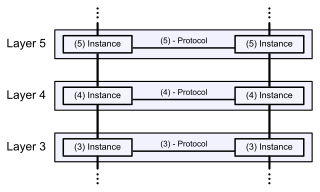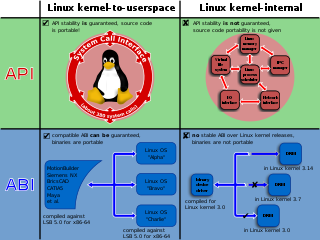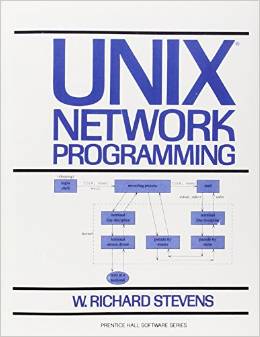Related Research Articles

The Open Systems Interconnection model is a conceptual model from the International Organization for Standardization (ISO) that "provides a common basis for the coordination of standards development for the purpose of systems interconnection." In the OSI reference model, the communications between a computing system are split into seven different abstraction layers: Physical, Data Link, Network, Transport, Session, Presentation, and Application.
The Portable Operating System Interface is a family of standards specified by the IEEE Computer Society for maintaining compatibility between operating systems. POSIX defines both the system and user-level application programming interfaces (APIs), along with command line shells and utility interfaces, for software compatibility (portability) with variants of Unix and other operating systems. POSIX is also a trademark of the IEEE. POSIX is intended to be used by both application and system developers.
The Single UNIX Specification (SUS) is a standard for computer operating systems, compliance with which is required to qualify for using the "UNIX" trademark. The standard specifies programming interfaces for the C language, a command-line shell, and user commands. The core specifications of the SUS known as Base Specifications are developed and maintained by the Austin Group, which is a joint working group of IEEE, ISO/IEC JTC 1/SC 22/WG 15 and The Open Group. If an operating system is submitted to The Open Group for certification, and passes conformance tests, then it is deemed to be compliant with a UNIX standard such as UNIX 98 or UNIX 03.
Xerox Network Systems (XNS) is a computer networking protocol suite developed by Xerox within the Xerox Network Systems Architecture. It provided general purpose network communications, internetwork routing and packet delivery, and higher level functions such as a reliable stream, and remote procedure calls. XNS predated and influenced the development of the Open Systems Interconnection (OSI) networking model, and was very influential in local area networking designs during the 1980s.
Berkeley sockets is an application programming interface (API) for Internet sockets and Unix domain sockets, used for inter-process communication (IPC). It is commonly implemented as a library of linkable modules. It originated with the 4.2BSD Unix operating system, which was released in 1983.
An application layer is an abstraction layer that specifies the shared communication protocols and interface methods used by hosts in a communications network. An application layer abstraction is specified in both the Internet Protocol Suite (TCP/IP) and the OSI model. Although both models use the same term for their respective highest-level layer, the detailed definitions and purposes are different.
In computing, the Windows Sockets API (WSA), later shortened to Winsock, is an application programming interface (API) that defines how Windows network application software should access network services, especially TCP/IP. It defines a standard interface between a Windows TCP/IP client application and the underlying TCP/IP protocol stack. The nomenclature is based on the Berkeley sockets API used in BSD for communications between programs.
William Richard (Rich) Stevens was a Northern Rhodesia–born American author of computer science books, in particular books on UNIX and TCP/IP.

Unix System V is one of the first commercial versions of the Unix operating system. It was originally developed by AT&T and first released in 1983. Four major versions of System V were released, numbered 1, 2, 3, and 4. System V Release 4 (SVR4) was commercially the most successful version, being the result of an effort, marketed as Unix System Unification, which solicited the collaboration of the major Unix vendors. It was the source of several common commercial Unix features. System V is sometimes abbreviated to SysV.
X/Open group was a consortium founded by several European UNIX systems manufacturers in 1984 to identify and promote open standards in the field of information technology. More specifically, the original aim was to define a single specification for operating systems derived from UNIX, to increase the interoperability of applications and reduce the cost of porting software. Its original members were Bull, ICL, Siemens, Olivetti, and Nixdorf—a group sometimes referred to as BISON. Philips and Ericsson joined in 1985, at which point the name X/Open was adopted.

The Linux kernel provides several interfaces to user-space applications that are used for different purposes and that have different properties by design. There are two types of application programming interface (API) in the Linux kernel that are not to be confused: the "kernel–user space" API and the "kernel internal" API.
In C programming, the functions getaddrinfo and getnameinfo convert domain names, hostnames, and IP addresses between human-readable text representations and structured binary formats for the operating system's networking API. Both functions are contained in the POSIX standard application programming interface (API).
In computer networking, STREAMS is the native framework in Unix System V for implementing character device drivers, network protocols, and inter-process communication. In this framework, a stream is a chain of coroutines that pass messages between a program and a device driver. STREAMS originated in Version 8 Research Unix, as Streams.
Computer network programming involves writing computer programs that enable processes to communicate with each other across a computer network.
A network socket is a software structure within a network node of a computer network that serves as an endpoint for sending and receiving data across the network. The structure and properties of a socket are defined by an application programming interface (API) for the networking architecture. Sockets are created only during the lifetime of a process of an application running in the node.
A Unix domain socket aka UDS or IPC socket is a data communications endpoint for exchanging data between processes executing on the same host operating system. It is also referred to by its address family AF_UNIX. Valid socket types in the UNIX domain are:

A Unix-like operating system is one that behaves in a manner similar to a Unix system, although not necessarily conforming to or being certified to any version of the Single UNIX Specification. A Unix-like application is one that behaves like the corresponding Unix command or shell. Although there are general philosophies for Unix design, there is no technical standard defining the term, and opinions can differ about the degree to which a particular operating system or application is Unix-like.
The X/Open Transport Interface (XTI) is an Open Group specification for network application programming present in UNIX System V operating systems. It provides OSI transport layer services with protocol independence. Although Open Group considers this specification withdrawn, an implementation is part of the standard programming interfaces on modern UNIX System V operating systems where it is implemented using the STREAMS character input/output mechanism.

Unix Network Programming is a book written by W. Richard Stevens. It was published in 1990 by Prentice Hall and covers many topics regarding UNIX networking and Computer network programming. The book focuses on the design and development of network software under UNIX. The book provides descriptions of how and why a given solution works and includes 15,000 lines of C code. The book's summary describes it as "for programmers seeking an in depth tutorial on sockets, transport level interface (TLI), interprocess communications (IPC) facilities under System V and BSD UNIX." The book has been translated into several languages, including Chinese, Italian, German, Japanese and others.

In computer science, shared memory is memory that may be simultaneously accessed by multiple programs with an intent to provide communication among them or avoid redundant copies. Shared memory is an efficient means of passing data between programs. Depending on context, programs may run on a single processor or on multiple separate processors.
References
- Goodheart, Berny; Cox, James (1994). The magic garden explained: the internals of UNIX System V Release 4, an open-systems design. Australia: Prentice Hall. ISBN 0-13-098138-9.
- Nuss, Branko (January 2000). RTFM!!! Issue 5.2. CAE Specification. Vol. 1 (1.0 ed.). Akron, OH: Addison-Wesley.
- Pajari, George (1992) [1991]. Writing UNIX Device Drivers (2nd Printing ed.). Reading, MA: Addison-Wesley. ISBN 0-201-52374-4.
- Santa Cruz Operation (1997) [1995]. System V Application Binary Interface — Intel386 Architecture Processor Supplement (4th ed.). Santa Cruz, CA: The Santa Cruz Operation, Inc.
- Santa Cruz Operation (1997) [1995]. System V Application Binary Interface (4.1th ed.). Santa Cruz, CA: The Santa Cruz Operation, Inc.
- Stevens, W. Richard (1990). UNIX Network Programming. Englewood Cliffs, N.J.: Prentice-Hall. ISBN 0-13-949876-1.
- Stevens, W. Richard (1993). Advanced Programming in the UNIX Environment (1st Edition, 15th Printing ed.). Reading, MA: Addison-Wesley. ISBN 0-201-56317-7.
- Thomas, Rebecca; Lawrence R. Rogers; Jean L. Yates (1986). Advanced Programmers Guide to UNIX System V. Berkeley, CA: Osborne McGraw-Hill. ISBN 0-07-881211-9.
- UNIX System Laboratories (1995). System V Application Binary Interface (4th ed.). Englewood Cliffs, N.J.: UNIX System Laboratories.
- Waite Group (1987). Mitchel Waite (ed.). UNIX Papers (2nd Printing ed.). Indianapolis, IN: Howard W. Sams & Company. ISBN 0-672-22578-6.
- Zucker, Steve; Kari Karhi (1995) [1993]. System V Application Binary Interface—PowerPc Processor Supplement. Mountain View, CA: SunSoft.